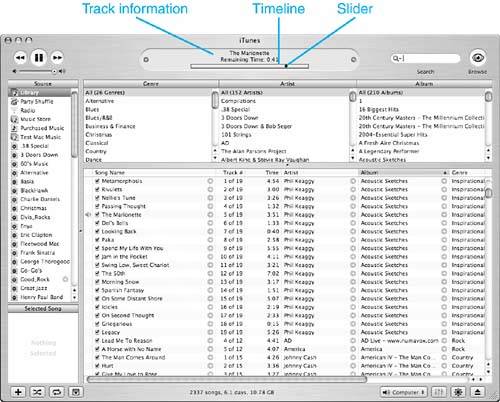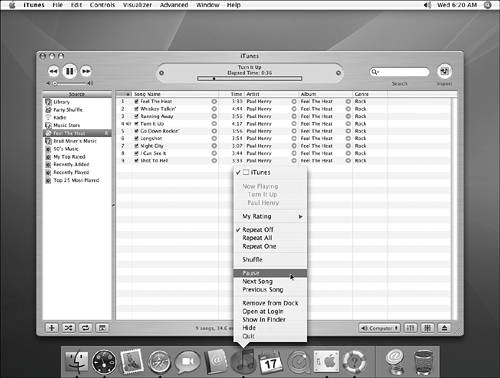| The most basic task for which you use iTunes is to listen to audio CDs. In addition to the capabilities provided by a "regular" CD player, iTunes provides several other features that leave regular CD players in the dust. CAUTION Some audio CDs use copyright protection schemes that prevent you from listening to the CD on a computer (with the idea being that you won't be able to make electronic versions of the songs for illegal purposes). Unfortunately, not only do these CDs not work in your Mac, but they can actually cause damage. Before playing a CD in your Mac, check the label carefully to ensure that its label doesn't contain any warnings about playing the CD in a computer or that the CD is copy-protected. If it does have such warnings, don't try to use the CD in your Mac.
Playing an Audio CD Playing an audio CD is straightforward. The following steps give you a quick run-through of the process for launching iTunes and playing a CD: 1. | Insert the audio CD. By default, iTunes opens (if it isn't open already) and moves to the front. A message telling you that iTunes is looking up the CD on the CDDB database will appear. Depending on how you connect to the Internet, this process can take a few moments. If multiple matches are found for the CD, you will be prompted to select the correct one. Do so, and then click OK. (This is done only the first time you listen to a CD because iTunes remembers CDs as you listen to them.)
If you have turned off the preference allowing iTunes to automatically check for information, this step is skipped. Also, if you have a dial-up connection and you don't allow applications to automatically connect, you have to make the connection manually for this to work.
The CD is mounted and appears in the Source pane.
| 2. | The CD should be selected as the source automatically; if it isn't, select the CD as the source. Its contents will appear in the Content pane. You might have to resize the window and the columns to be able to see all the CD's information. The Source Information area shows information about the CD's contents, such as the number of tracks and total playing time.
| 3. | Click the Play button and use the other playback controls to control the music. The controls work just like you expect them to. For example, to skip to the next track, click the Fast Forward/Next Track button. As the CD plays, information about it, such as the CD name, artist name, and so on, will appear in the Information window. Along with this, a timeline bar will appear with a diamond-shaped slider in it to visually represent the progress of playing the song (see Figure 18.6).
Figure 18.6. You can drag the iTunes slider to move to any point in a song. 
|
Playing an audio CD is as easy as pie (whatever that means). Here are a few tips for you: You can play a track by double-clicking it. If you uncheck the box next to a track's title, it will be skipped. You can change the order in which tracks play by dragging them up and down in the window; iTunes remembers this order and the next time you insert the CD, the same playing order will be used again. You can move around within a song by dragging the slider that appears in the timeline below the song's information in the Information window. The track currently playing is marked with a speaker icon in the Content pane. You can jump to the current song by selecting File, Show Current Song or by pressing  -L. -L.
Configuring iTunes for Audio CDs By default, iTunes launches automatically when you insert an audio CD and then looks up its information. However, you can configure what happens when you insert an audio CD into your Mac by using the following steps: 1. | Open the System Preferences application and click the CDs & DVDs button.
| 2. | On the "When you insert a music CD" pop-up menu, select the action you want your Mac to take. By default, this is Open iTunes. Your other choices are "Open other application," which enables you to select a different application to launch when you insert an audio CD; "Run script," which enables you to choose an AppleScript to be executed; and Ignore, which causes your Mac to do nothing.
| 3. | Quit the System Preferences application.
| 4. | Back in iTunes, select iTunes, Preferences.
| 5. | Click the General tab if it isn't selected already.
| 6. | Using the On CD Insert pop-up menu, select the action you want iTunes to take when you insert an audio CD. The options are the following:
- Show Songs The CD becomes available in the Source pane, but no action is taken.
- Begin Playing The CD will begin playing automatically.
- Import Songs The tracks on the CD will be added to your Library. (More about this later.)
- Import Songs and Eject The tracks on the CD will be added to your Library. When that process is complete, the CD will be ejected.
| 7. | If you don't want iTunes to connect to the Internet when it needs to, such as to look up a CD's information or access the iTunes Music Store, uncheck the "Connect to Internet when needed" check box.
| 8. | Click OK. The CD actions you selected will become active.
|
Controlling Music Playback from the Dock You can control iTunes from the Dock by opening its menu (see Figure 18.7). In addition to playback controls, you can see the name and artist of the current track, rate it, and so on. Figure 18.7. The iTunes Dock menu enables you to get information about and control the music currently playing. 
NOTE While I have included information on controlling music playback in the section about playing audio CDs, but it is equally applicable to listening to music from any source.
Controlling iTunes Using Its Dashboard Widget One of the standard widgets that comes with Mac OS X enables you to control iTunes. The controls the widget provides are pretty basic, but when you want to make quick changes to iTunes, they will likely be all you need (see Figure 18.8). Figure 18.8. Using the iTunes widget, you can control iTunes without being in the application. 
 To learn how to use widgets, p. 160. To learn how to use widgets, p. 160.
The controls in the iTunes widget work just like the controls within iTunes with a couple of exceptions. The volume control in the widget is the outer "ring" on the left side of the widget. Drag the dot clockwise to increase the volume or counterclockwise to decrease it. When you change the volume, the slider is replaced by a graphic representation of the current volume level. When you release the volume control, the timeline will reappear. Another exception is that you can't change the information displayed in the widget; you will always see the title of the current song playing. |



 To learn how to use widgets,
To learn how to use widgets,